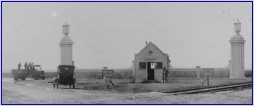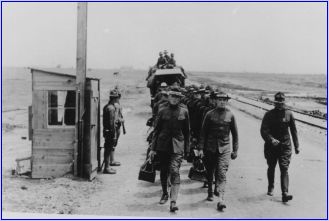|
Lieutenant Kelly’s death caused the Commander at Fort Sam Houston to call a halt to flying at the Post. Aviation didn’t return to the Alamo City until November 1915, when the First Aero Squadron arrived from Fort Sill, Oklahoma. It did not stay long. In March 1916, the Mexican Revolutionary leader, Pancho Villa, attacked Columbus, New Mexico, and the First Aero Squadron, commanded by Foulois, joined a p unitive expedition commanded by General John J. Pershing. Within months all its few aircraft were grounded. With World War I raging in Europe, it was clear that American military aviation needed to expand. Foulois, now a major, was called upon to form new squadrons and find a training site. In November 1916, he returned once again to San Antonio. Lacking space to expand at Fort Sam Houston, Foulois looked for another site for an aviation camp, choosing a 700-acre track of land southwest of San Antonio. The land was leased in January 1917. What was once cotton, cabbage, mesquite and cactus, was overrun with men and machines clearing the way for a landing field. On April 5th 1917, the first four planes slid out of the sky to land at the new field. The United States entered World War I the next day. Named Kelly Field in July, the new field was seen training aviators, mechanics, and support personnel destined for duty in France. Within 18 months, Kelly was the largest aviation training, classification and reception center in the United States. With the end of the war to end all wars, Kelly Field was consumed by the lethargy that follows most armed conflicts. The United States adopted an isolationist attitude and military aviation lapsed into a period of near hibernation. Aircraft that had been built for war were now turned to barnstorming and amusement. Throughout the nation aviation camps and depots were closing, but at Kelly Field unitive expedition commanded by General John J. Pershing. Within months all its few aircraft were grounded. With World War I raging in Europe, it was clear that American military aviation needed to expand. Foulois, now a major, was called upon to form new squadrons and find a training site. In November 1916, he returned once again to San Antonio. Lacking space to expand at Fort Sam Houston, Foulois looked for another site for an aviation camp, choosing a 700-acre track of land southwest of San Antonio. The land was leased in January 1917. What was once cotton, cabbage, mesquite and cactus, was overrun with men and machines clearing the way for a landing field. On April 5th 1917, the first four planes slid out of the sky to land at the new field. The United States entered World War I the next day. Named Kelly Field in July, the new field was seen training aviators, mechanics, and support personnel destined for duty in France. Within 18 months, Kelly was the largest aviation training, classification and reception center in the United States. With the end of the war to end all wars, Kelly Field was consumed by the lethargy that follows most armed conflicts. The United States adopted an isolationist attitude and military aviation lapsed into a period of near hibernation. Aircraft that had been built for war were now turned to barnstorming and amusement. Throughout the nation aviation camps and depots were closing, but at Kelly Field the pace had merely slowed not stopped. For a time, all the active flying groups were stationed at Kelly. Then in 1922, the Air Service restructured its training program, making Kelly home to the Air Service Advanced Flying School. For the next two decades, Kelly would become famous as the alma mater of the Air Corps. During these years, some of aviation’s greatest names pressed the rudder pedals of Kelly trainers. Early graduates of the Advanced Flying School include “lone eagle” Charles Lindbergh; General Curtis LeMay, cigar chopping advocate of strategic air power; and future Air Force Chiefs of Staff Hoyt S. Vandenburg, Thomas D. White, John McConnell and George S. Brown. the pace had merely slowed not stopped. For a time, all the active flying groups were stationed at Kelly. Then in 1922, the Air Service restructured its training program, making Kelly home to the Air Service Advanced Flying School. For the next two decades, Kelly would become famous as the alma mater of the Air Corps. During these years, some of aviation’s greatest names pressed the rudder pedals of Kelly trainers. Early graduates of the Advanced Flying School include “lone eagle” Charles Lindbergh; General Curtis LeMay, cigar chopping advocate of strategic air power; and future Air Force Chiefs of Staff Hoyt S. Vandenburg, Thomas D. White, John McConnell and George S. Brown.
|